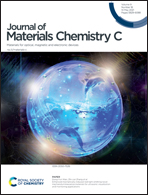A new lead-free 1D hybrid copper perovskite and its structural, thermal, vibrational, optical and magnetic characterization†
Abstract
A hybrid material based on a 1D copper chloride perovskite network with hexahydro-1,4-diazepine, (C5H14N2)[CuCl4], was grown at room temperature by slow evaporation. This compound crystallizes in the monoclinic space group P21/n. The framework is constructed from double edge-sharing copper chloride chains surrounded by organic cations to form a multiquantum well structure. The TG–DTA measurement shows that our compound is stable at ambient temperature and exhibits an endothermic phase transition at 83 °C. UV-Vis spectroscopy reveals that the Jahn–Teller effect arising at the Cu2+ cation within the CuCl6 octahedra confers additional flexibility to the structure. The gap energy value was estimated to be 2.56 eV, which indicates that the new hybrid compound should be a semiconducting material. To the best of our knowledge, this is the first 1D copper(II) based perovskite, laying the foundation for further development of perovskites as alternative lead-free materials for solar cells. Magnetic measurements indicate the absence of magnetic interactions which are proposed to result from the cancelation of antiferromagnetic and ferromagnetic contributions.



 Please wait while we load your content...
Please wait while we load your content...